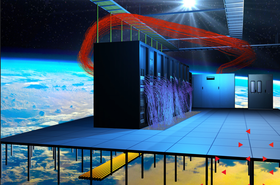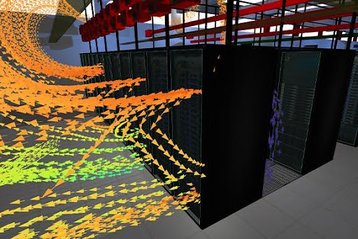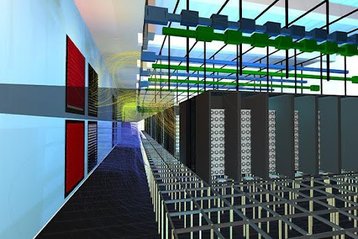Digital twins in the data center industry
Digital twins are necessary in the data center industry when dealing with ever-changing IT – not the least due to the escalating use of AI and high-density equipment. Big and small businesses alike rely on data centers to house and process their data with resilience, security, and efficiency. The increase in power-hungry technology means data centers must perform like never before.
Data centers are designed at a single point in time but are expected to keep pace with technological advancements that span years, if not decades. Not only must they remain online 24/7, but they must also utilize their capacity in an energy-efficient manner, with environmental regulations looming on the horizon. Many are forced to rush their IT deployment to keep pace with business demands, leading to increased risk and stranded capacity.
There is an urgent need to provide technologies that support a more environmentally responsible approach to the undeniable escalation of AI workloads and their impact on the data center industry. That’s where digital twin technology shines.
Revolutionizing decision-making in real-time with Cadence Reality DC
Cadence Reality DC enables data center operators to make informed decisions by simulating multiple scenarios in a virtual environment. These allow the operators to avoid problematic configurations, thereby minimizing risks and enhancing operational efficiency. Cadence Reality DC supports adopting cutting-edge technologies, such as liquid cooling, ensuring optimal performance and sustainability, not just for complete refits or new designs but also when partial updates to new cooling technologies are being made.
Key features and benefits
- Enhanced decision-making: Virtualize the entire data center ecosystem to analyze and optimize operations without impacting live environments
- Energy efficiency: Customizable dashboards and automated reporting features track ESG metrics and sustainability goals, addressing global power usage concerns
- AI high-density support: Model and test high-power density equipment scenarios to ensure efficient cooling and energy utilization
- Integrated solutions: Manage power connectivity, data network connectivity, and external environmental factors under one platform using advanced modeling tools
Addressing industry challenges
Performing analysis in a virtual replica – rather than a live data center – enables better decision-making without risk. A digital twin can analyze multiple scenarios before deciding upon a course of action without impacting anything in the live data center environment.
Cadence Reality DC enables visibility across the entire value chain, using models built with smart equipment to ensure that the digital twin model behaves accurately and demonstrates how the combined control systems behave in conjunction.
It also supports adopting innovative technologies by enabling operators to model and test how their data center will behave before any new implementation. For example, customers are modeling liquid cooling scenarios within Cadence Reality DC to understand efficiencies and facilitate more effective cooling in the face of high-density equipment. Enabling the effective adoption of liquid or a combination of liquid and air cooling will be critical for catering to the high-power density equipment emerging alongside AI.
Data centers are also under pressure to prioritize sustainability and energy efficiency. Data center power usage effectiveness (PUE) scores have stagnated in recent years at around PUE 1.5, with best-in-class data centers consistently scoring PUE 1.1.
Many data centers globally might use five times more overhead energy than necessary. With a global data center usage of around two percent of global power usage, data center technologies that support a path to a greener future should be adopted quickly. Cadence Reality DC offers customizable dashboards on energy efficiency and includes automated reporting features that make it easy to track ESG-related metrics and meet sustainability goals.
Although Cadence Reality DC is well known for and can model any data center configuration, including complex cooling strategies and modern control systems, data center professionals can use the software for much more than air and liquid cooling performance. The inclusion of data networks, power, cooling, and internal and external modeling tools make managing more aspects of data center design and operations easier.
The digital twin model allows data center professionals to track and plan deployment with placement suggestions based on the necessary IT requirements and availability. Teams can test these deployment options and failure scenarios to study the implications of different power, loading, and cooling scenarios.
The software naturally organizes large volumes of data, tracks changes, and automates customized reports with photorealistic images and videos to ensure that not only does the correct data get to the right stakeholders, but that data is intuitive and easy to understand. The software can also visualize data center performance with industry metrics, including ASHRAE compliance metrics, PUE, and SLA compliance.
Whatever your processes, the software streamlines modeling, solving, and reporting with intelligent items (i.e. objects that know how to behave/interact with other objects and the environment), solver automation, and single-click reporting. Integrations with environmental monitoring systems, ticketing software, data center infrastructure management (DCIM), and CSV spreadsheets automate model upkeep and prevent any need for duplication of effort/entry. Further, it can perform transient simulations to understand how the data center will operate over time and in failure scenarios.
Cadence Reality DC provides tools and data analysis for many aspects. With it, you can manage power connectivity using circuit phase, distribution voltage, failure currents, and more.
Teams can analyze data network connectivity with port-to-port connectivity management. Specific offerings in the software can simulate airflow and cooling using computational fluid dynamics (CFD) to identify cooling performance inefficiencies, reduce deployment risks, optimize energy efficiency, and increase capacity utilization.
The software includes external modeling functionality so engineers can analyze the impact of external environmental factors, including wind profiles, terrain roughness, humidity, solar gain, and even whether the design ejects the exhaust emission contamination from generators effectively.
For more information, visit Cadence Reality DC.
More from Cadence
-

Sponsored Cadence Reality Digital Twin platform to transform data center design for the AI era
Revolutionary platform improves energy efficiency by up to 30 percent with accurate and lightning-fast AI-driven digital twins
-

-

Discover the future of data center design with Cadence Reality DC
Key features of physics-based CFD simulation software


